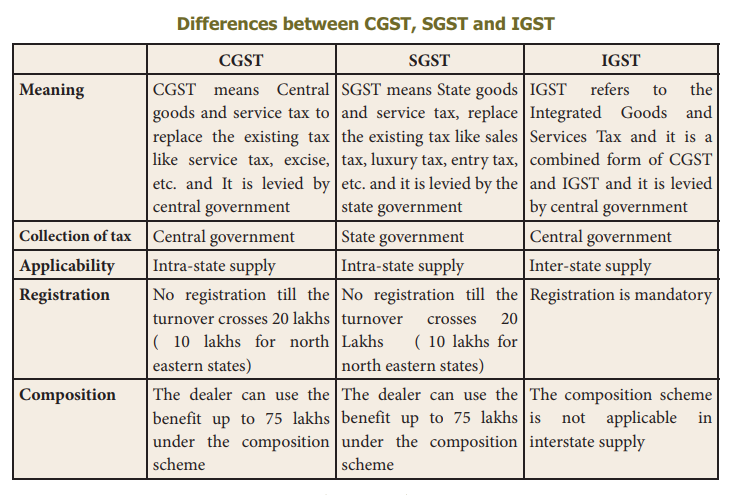Objectives, Benefits, Disadvantages of GST - GST Council | 11th Commerce : Chapter 33 : Indirect Taxation
Chapter: 11th Commerce : Chapter 33 : Indirect Taxation
GST Council
GST Council
The GST Council will oversee the
implementation of the GST. But the Central
Board of Excise
and Customs is responsible
for administration of the CGST and IGST Acts. The Council makes
recommendations on rate of GST, apportionment of IGST, exemptions, model GST
laws, etc.

The Chairman of the Council is the Union
Finance Minister. The Minister of
State in the Finance Ministry and all Finance Ministers of the State
Governments shall be its members. The Central Government shall have 1/3rd
voting power and all State Governments shall have 2/3rd voting powers. All
decisions of the Council can be passed only with ¾th of the total votes. Each
state has one vote, irrespective of its size or population. Twenty four council
meetings were held until 2017.
Apart from the GST Council, GST Secretariat was formed with the following officials
i. The Secretary (Revenue) will be appointed as the Ex-officio Secretary to the GST Council.
ii. The Chairperson, Central Board of
Excise and Customs (CBEC), will be a permanent invitee (non-voting).
iii. One post of Additional Secretary to
the GST, and
iv. Four posts of Commissioner in the
GST Council Secretariat will also be created.
Objectives of GST
i.
The foremost objective of GST is to
create a common market with uniform tax rate in India. (One Nation, One Tax,
One Market)
ii.
To eliminate the cascading effect of
taxes, GST allows set-off of prior taxes for the same transactions as input tax
credit.
iii.
To boost Indian exports, the GST already
collected on the inputs will be refunded and thus there will be no tax on all
exports.
iv.
To increase the tax base by bringing
more number of tax payers and increase tax revenue.
v.
To simplify tax return procedures
through common forms and avoidance of visiting tax departments.
vi.
To provide online facilities for payment
of taxes and submission of forms. Goods and Services Network (GSTN), a robust
Information Technology system has been created for the operation of GST.
Benefits of GST
A. To the Society and country
1.
Unified common national market will
attract more foreign investment. GST has integrated the economy of all States
and Union Territories.
2.
It brings parity in taxation among
imported goods and Indian manufactured goods. All imported goods will be
charged with IGST which will be more or less equivalent to the total of CGST
and SGST levied on manufactured goods. Removal of several taxes will make the
price of Indian products more competitive at world market.
3.
It will boost manufacturing, export, GDP
leading to economic growth through increase in economic activity.
4.
Creation of more employment
opportunities which will result in poverty eradication.
5.
It will bring more tax compliance (more
tax payers) and increase revenue to the Governments.
6.
It is transparent and will improve
India’s ranking in the ‘Ease of Doing Business’ in the world.
7.
Uniform rates of tax will reduce tax
evasion and rate arbitrage between States.
B. To Business Community
1.
Simpler Tax System with fewer
exemptions. 17 taxes were abolished and one tax exists today.
2.
Input tax credit will reduce cascading
effect of taxes. Reduction in average tax burden will encourage manufacturers
and help “Make in India” campaign and make India as a manufacturing hub.
3.
Common procedures, common classification
of goods and services and timelines will lend greater certainty to taxation
system.
4.
GSTN facility will reduce multiple
record keeping, lesser investment in manpower and resources and improve
efficiency.
5.
All interactions will be through common
GSTN portal and will ensure corruption free administration.
6.
Uniform prices throughout the country.
Expansion of business to all states is made easy.
C. To Consumers
1.
Input tax credit allowed will lower the
prices to the consumers.
2.
All small retailers will get exemption
and purchases from them will cost less for the consumers.
Disadvantages of GST
Besides the above listed advantages the
GST is also criticized for many reasons. The disadvantages of GST are stated
below:
1.
Several Economists says that GST in
India would impact negatively on the real estate market. It would add up to 8
percent to the cost of new homes and reduce demand by about 12 percent.
2.
Another criticism is that CGST, SGST are
nothing but new names for Central Excise/Service Tax, VAT and CST. Hence, there
is no major reduction in the number of tax layers.
3.
A number of retail products currently
have only four percent tax on them. After GST, garments and clothes could
become more expensive.
4.
The aviation industry would be affected.
Service taxes on airfares currently range from six to nine percent. With GST,
this rate will surpass fifteen percent and effectively double the tax rate.
5.
Adoption and migration to the new GST
system would involve teething troubles and learning for the entire ecosystem.
Related Topics